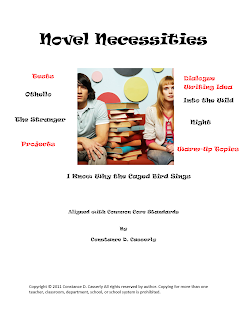With barely time to breathe that first week of school, the introductions to the school staff, the PTA-sponsored food fests and the camaraderie of the teacher work days were relegated to my memory bank. Classrooms forty-three years ago proved that one could be lonely in a crowd. Today, the nature of teaching still can make us feel isolated from our colleagues.Now, though, antidotes for the loneliness of the full-time teacher are found in the plethora of social media sites.
Facebook, Twitter and LinkedIn, for three, offer
- opportunities for connecting with teachers around the world
- insight into issues that affect educators,
- places to vent about the frustrations and to share the successes of this most honorable profession, and oh so important in connecting teachers with the world outside of the classroom,
- treasure chests overflowing with teaching tips, activities and classroom management ideas.
Two sites that I love give teachers the opportunity to collect lessons that they can use in the classroom.
A few months ago, Nicholas Klacsanzky, the Content Coordinator of AcademicHelp (http://academichelp.net/) contacted me on LinkedIn about this site. It hooked me with its How To content for virtually any type of Academic or non-Academic writing. Classroom teachers as well as tutors will find detailed writing guides and activities to augment their own writing plans. Here is AcademicHelp's site intro-in their own words:
"AcademicHelp.net is a free writing guide with tutoring
material on practically any type of academic or non-academic writing task.
Our writing guides and samples cover a variety of life’s
spheres where you might face the challenge of having to write a document, a
paper, or a reference. All our guides, along with their related samples, are
logically organized in sections and subsections. AcademicHelp.net is a free
resource aimed at nothing but helping us all become better writers."
Just reading their Table of Contents made my heart palpitate with the What If excitement I experienced when I was still in the teaching trenches and found ways to empower my students to be better writers.
The About Us link (http://academichelp.net/about-us.html) explains that
"AcademicHelp.net is:
- a completely free resource.
- a great teacher, with countless guides to teach you how to complete any writing assignment.
- a collection of hundreds of samples to show you examples of format, style, and the quality that is expected.
- a forum for asking questions about your assignments – answered by our experts.
- a plagiarism checker to make sure that your content is free of accidental plagiarism."
Marjan Glavac writes and publishes an amazing FREE newsletter, The Busy Educator Newsletter every week (http://news.thebusyeducator.com/). This on-line source provides articles focused on specific teaching ideas, issues, stories, technology updates, videos, health-related pieces, and leisure items from around the web that will hook teachers' interests. Another plus is that Mr. Glavac welcomes teachers-yes, you- to share your lesson ideas.
Not only is Mr. Glavac a retired teacher and a newsletter publisher, but he is also an author. He is offered two inspiring reads for teachers.
How to Thrive and Survive in Your Classroom is on sale for half price until December 31, 2013.
In his book blurb he asks, "Do You Want To Know How To Create Your Ideal Classroom, Motivate Your Students, Maintain Their Attention And Keep Them On Task Without Screaming, Pleading Or Burning Yourself Out?” This marvelous book is a practical guide for everything from setting up a classroom, to time management, to instructional and behavioral techniques. Check it out.
How many times have you thought about writing your teaching memoirs? I know I have- I even have a title, What I need is the time, energy and inspiration to create an idea outline with the anecdotes I want to include. Here is Mr. Glavac's memoir, Teaching Is: Moments that Inspire and Motivate Teachers
to Make a Difference. Need a gift for a colleague, a retired teacher, or yourself? if so, you can find this five-star book on Amazon.com.
This post blossomed from my desire to share these sites that have kept me connected to educational matters, to the classroom and to my teaching colleagues-from my days in the classroom as well as from my Facebook, Twitter and LinkedIn friends. In this season of giving, I wanted to tell you about these sites, if you haven't found them already. They have kept me inspired, in the education loop, passionate about this profession that I love. Because of these sites and oh, so many more, teachers might be alone in the classroom, but they aren't lonely.
Thank you all, my Facebook, Twitter, LinkedIn connections and my followers on this site, for giving me the gift of friendship and for sharing your inspiring teaching ideas, your frustrations and your joys.
This post blossomed from my desire to share these sites that have kept me connected to educational matters, to the classroom and to my teaching colleagues-from my days in the classroom as well as from my Facebook, Twitter and LinkedIn friends. In this season of giving, I wanted to tell you about these sites, if you haven't found them already. They have kept me inspired, in the education loop, passionate about this profession that I love. Because of these sites and oh, so many more, teachers might be alone in the classroom, but they aren't lonely.
Thank you all, my Facebook, Twitter, LinkedIn connections and my followers on this site, for giving me the gift of friendship and for sharing your inspiring teaching ideas, your frustrations and your joys.



































